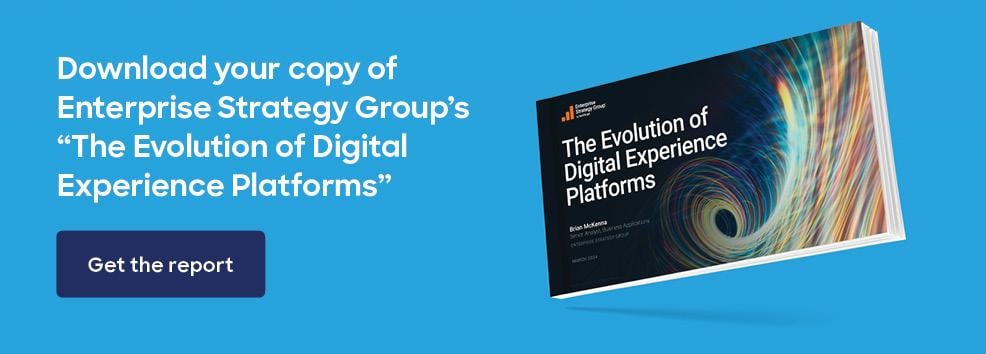Decoding the Current State of Digital Experience Platforms

For the better part of two decades, the content management system (CMS) was viewed as the most important tool to get right for delivering what we now call digital experiences. But marketers' needs have expanded with the demand for consistent, personalized experiences in an omnichannel world – giving rise to the digital experience platform (DXP).
DXPs offer a central hub to create, manage, deliver, and optimize content-driven experiences across all digital channels. But with the various capabilities they encompass, use cases they serve, and options for deployment, it's not uncommon for marketers to have questions about how to chart the right path.
With this in mind, Acquia sponsored research from TechTarget’s Enterprise Strategy Group, “The Evolution of Digital Experience Platforms.” Summarizing findings from a survey of 370 business and IT leaders, the report details the business drivers behind DXP adoption, the most common DXP capabilities organizations utilize, and more. The full report is available now, and we’ll highlight a few insights.
Driving growth is the top reason organizations are investing in DXPs
DXPs enable organizations to provide a fully integrated and seamless digital experience across channels throughout the entire customer journey, which is critical to meeting the heightened expectations of audiences who demand the right content, at the right time, on any device they’re using. That’s likely the reason why, when asked to select a reason best describing why their organization is either implementing or planning to implement DXP technology, participants in Enterprise Strategy Group’s survey ranked "Enhance future growth strategy” at the top, earning 27% of votes from among 17 business goals.

Unsurprisingly, key business stakeholders consider the ability to deliver more effective digital experiences as integral to future growth. Success also hinges on the ability to deliver personalized content and messaging quickly and at scale. Indeed, enhanced personalization (21%), delivery speed (23%), and improved scalability (22%) were also cited among the top seven reasons here.
DXPs are seen as a way to build stronger bonds with customers
Marketers are keenly aware that third-party cookies are scheduled to disappear as early as this year. For many brands, that means establishing one-to-one relationships with customers and gathering first-party data has become paramount. Acquia’s 2023 CX Trends Report supports this. In it, a clear majority (93%) of marketers said that gathering first-party data is more important to their organization than it was two years ago.
So, when asked what DXP features and functionality were considered most valuable to their organization, it makes sense that respondents to Enterprise Strategy Group’s survey ranked customer relationship management (50%) and analytics and content intelligence (43%) as the top two choices. It highlights business stakeholders’ need to better understand audiences and then manage and nurture customer relationships effectively.
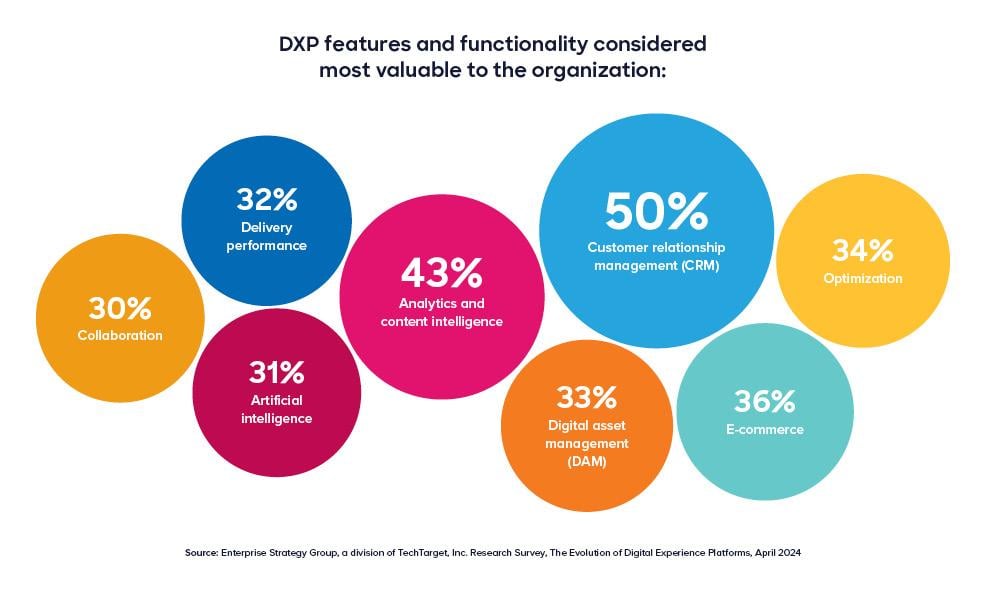
Business leaders recognize the important role data-driven insights and content intelligence play in optimizing digital experiences. By harnessing data analytics within DXPs, brand leaders can gain a deeper understanding of customer preferences, trends, and engagement patterns. This enables business teams to refine content strategies, personalize interactions, and deliver relevant, compelling experiences that resonate more effectively — all of which builds stronger bonds with customers and drives sustainable growth.
Not just customers: DXPs also deliver value for employees
While DXPs are primarily associated with enhancing customer-facing digital experiences, Enterprise Strategy Group found that employee experience/training followed closely behind customer success (52% and 59%, respectively) as the primary use case a DXP does, or will, enable for respondent’s organizations.
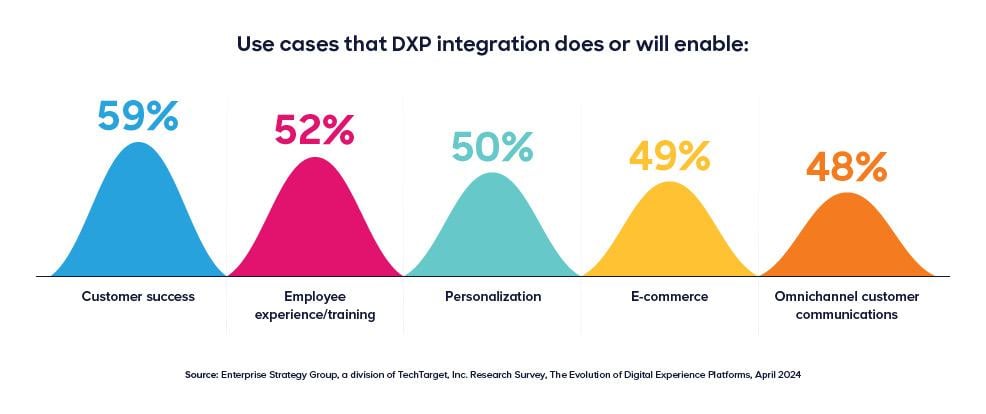
Leaders at many of the world’s top performing organizations understand that skilled and empowered employees are better equipped to deliver exceptional digital experiences, and thereby contribute to overall strategic success and customer satisfaction. And similar to how they support the customer experience, DXPs can improve collaboration, efficiency, and agility across departments. For example, DXPs facilitate seamless access to training materials, knowledge bases, and collaborative platforms, enabling employees to stay updated on industry trends, best practices, and company policies.
Business leaders want to simplify workflows and leverage automation from their digital experience ecosystem
Across competitive sectors, speed to market is important. However, Acquia’s 2023 CX Trends report found that 78% of marketers said they struggle to create content that can be rapidly released across all of their organization’s digital platforms in one go.
It’s not too surprising then, that when participants in Enterprise Strategy Group’s survey were asked what features and capabilities they felt were important to optimizing their DX ecosystem, workflow and routing (55%) topped the responses.
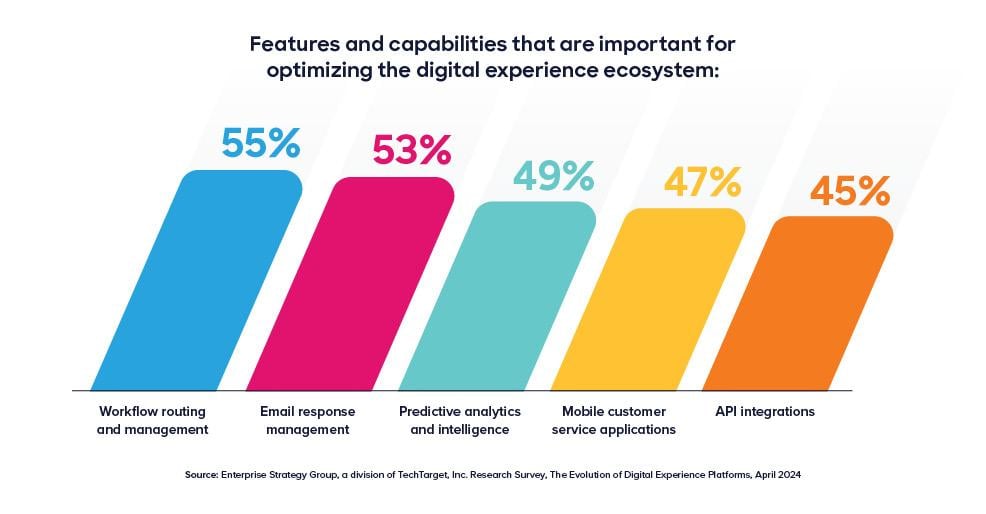
For instance, digital asset management (DAM) solutions – which centralize the storage, retrieval, and distribution of digital files – are often one of the key solutions within a DXP. With tools that streamline content creation workflows and help ensure seamless collaboration between content creators, editors, and reviewers, DXPs enable businesses to enhance operational efficiency, reduce manual errors, and get digital experiences to market faster.
The shift toward headless and hybrid CMSes is underway
The Enterprise Strategy Group survey’s question related to CMS architecture types made for some interesting results.
In terms of which CMS type is currently in use, the fact that traditional/monolithic CMS (58%) ranked above headless CMS (24%) and decoupled/hybrid CMS (31%) perhaps shouldn’t be surprising. It suggests that the simplicity and ease of use you get from a traditional CMS still appeals to organizations with straightforward content management needs.
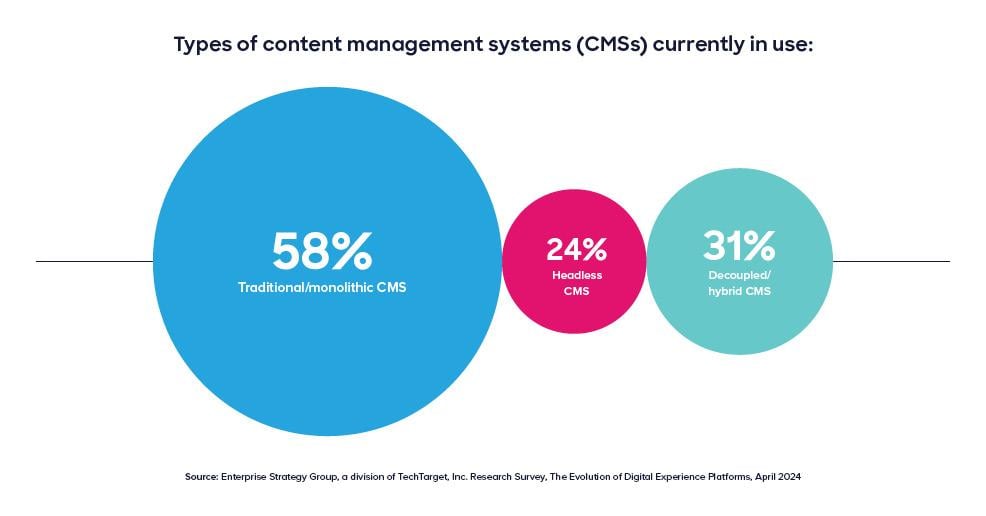
But take a closer look at which CMS types these leaders plan to deploy over the next 12 and 24 months. 36% of respondents say they are planning to use a headless CMS, while 38% say they are planning to use a hybrid CMS, making it the most popular selection for future adoption.
The gaining traction of headless and hybrid approaches, which both decouple content creation from its presentation, reinforces that organizations recognize the importance of flexibility and scalability in content management, especially as digital experiences evolve across various channels and devices. And for those evaluating DXP options, having flexibility among these CMS approaches might be important to factor into any decisions.
Takeaways
The report from Enterprise Strategy Group delivers several interesting points to consider when shaping strategies for delivering digital experiences. Though relatively new solutions, DXPs are considered important tools across many business sectors. A DXP that delivers flexibility, scalability, and data-informed customer experiences will help your brand or organization build a solid foundation for future growth.
Ultimately, organizations can deliver better experiences through a DXP that's aligned with their strategy. The open and composable Acquia DXP enables your teams to leverage the capabilities they need most to deliver optimized experiences.
